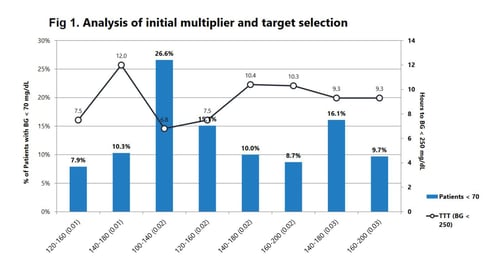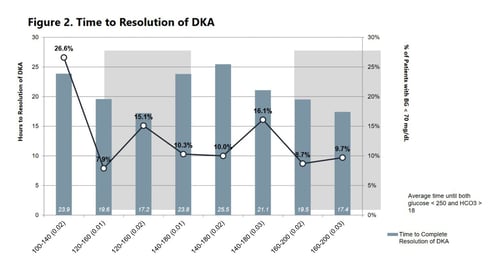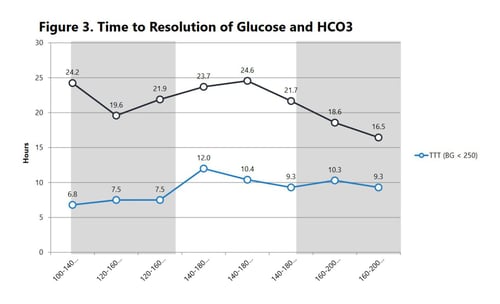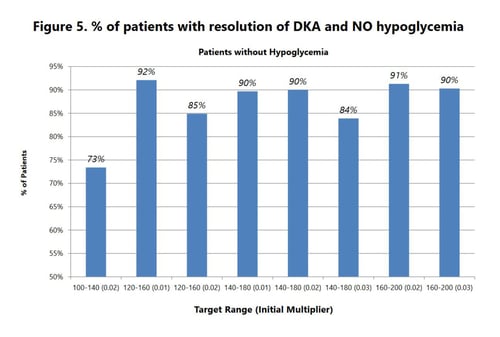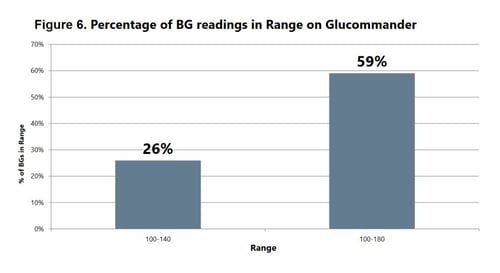Presentation
American Diabetes Association Scientific Sessions
Date
June 2016
Authors
David Reyes-Umpierrez,1 Francisco Pasquel,1 Raymie McFarland,2 Robby Booth,2 Bruce Bode,3 Guillermo Umpierrez1
Introduction
A variety of computer-based algorithms to direct nursing staff adjusting insulin infusion rate are commercially available for the management of hyperglycemia in critically ill patients.
The Glucommander (Glytec®) is an insulin delivery system that estimates the rate of insulin infusion using a multiplier or insulin sensitivity factor that for most patients ranges between 0.01 and 0.03.
No previous studies have determined what is the best initial multiplier and blood glucose target in patients with diabetic ketoacidosis (DKA).
Objectives
To evaluate the efficacy and safety of different multipliers, ranging from 0.01 to 0.03 targeting different blood glucose (BG) targets between in patients with DKA.
End points: Time to resolution of hyperglycemia, metabolic acidosis, and number of hypoglycemic events.
Research Design and Methods
Study Type: Multi-center, retrospective study of academic and non-academic institutions using the Glucommander for clinical care.
Patient Population: Patients admitted with DKA treated with Glucommander insulin delivery system in 34 medical centers (n= 1,750 patients).
- Hyperglycemia was defined as BG >200 mg/dl.
- Metabolic acidosis was defined as bicarbonate.
- Hypoglycemia defined as BG <70 mg/dl.
Summary
Best treatment outcomes were achieved with an initial multiplier of 0.01 and a glucose target range between 120 and 180 mg/dl. Using these parameters:
- The time to correct hyperglycemia and metabolic acidosis was 9.7±8.9 hours and 19.6±18.7 hours, respectively.
- A total of 32 (7.9%) patients had hypoglycemia.
There were no differences in the time to resolution of hyperglycemia or in the number of hypoglycemic events using a multiplier of 0.01 or 0.02 when BG target was between 120-180 mg/dl.
Initial multiplier of 0.03 or a lower BG target of 100-140 mg/dl resulted in higher rates of hypoglycemia (16.1% and 26.6%), respectively.
Table 1. Analysis of initial multiplier and target selection.
| Multiplier | 0.01 | 0.02 | 0.03 | |||||||||
|---|---|---|---|---|---|---|---|---|---|---|---|---|
| Target BG Range | N | BGs <70 | Patients <70 | TTT | N | BGs <70 | Patients <70 | TTT | N | BGs <70 | Patients <70 | TTT |
| 100-140 | 188 | 1.8% | 26.6% | 6.8 | ||||||||
| 120-160 | 103 | 0.5% | 7.9% | 7.5 | 311 | 0.9% | 15.1% | 7.5 | ||||
| 140-180 | 184 | 0.6% | 10.3% | 12.0 | 140 | 0.5% | 10.0% | 10.4 | 56 | 0.6% | 16.1% | 9.3 |
| 160-200 | 104 | 0.6% | 8.7% | 10.3 | 186 | 0.7% | 9.7% | 9.3 | ||||
Conclusion
The results of this study indicate that a conservative initial multiplier of 0.01 and a BG target of 120-180 mg/dl are safe and effective in treating patients with DKA when compared to other multipliers or tighter BG targets.
Affiliations
- Emory University School of Medicine, Atlanta, Georgia.
- Glytec, Waltham, Massachusetts.
- Piedmont Healthcare, Atlanta, Georgia.
